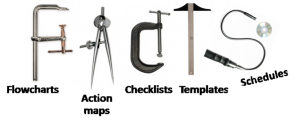I see this happening over and over again. Product managers (and others) shift into firefighting mode, working harder and putting in more hours. In an attempt to simplify their lives they seek out preconfigured templates to make their jobs easier. They fill in the blanks of the templates (sometimes almost mindlessly) and then move on to more ‘urgent’ matters. But did they make better decisions or plans because of the product management templates?
Do product management templates cause better decisions?
Perhaps yes. Perhaps no.
Let’s take a step back to think about what templates are. Historically, templates were patterns or molds used in technical or mechanical work. They guided the effective duplication or reproduction of something. The term was later extended to guide the effective duplication or reproduction of processes, plans, and approaches.
But if you duplicate the processes of others (including your competitors), are you really creating new successes? True, someone at some time put a great deal of thought into the content and “look” of the template. But does it contain the right set of questions? Does it have the right tenor at the right time for your particular situation? Does it provide you with novel insights? Can you really offload your decision-making responsibilities to a tool?
Templates may reduce errors of omission
Templates that help you ensure no critical factors are overlooked can be useful. They can highlight relevant topics and ideas to examine.They can provide a framework to organize your thinking. I admit I often use templates, and I have included many in my books and articles for others to use. But I always caution users to adapt and modify any template to their unique needs. Discard templates that no longer work.
Templates are just one tool in the toolbox
Let’s look at the FACTS. There are several tools you might consider in developing and implementing decisions, plans, processes and procedures. Templates are one tool, but there are others. Here are my tool facts:
 Flowcharts provide graphic representations (generally using symbols connected with lines) of sequential procedures. They provide visual cues and clues to better understand and follow standard approaches in a process or system. Project management is filled with flowcharts of select paths and overall modus operandi. Stage-gate processes, activity networks (such as critical path and PERT), and other step-by-step operations are examples. Some types of flowcharts, e.g., affinity diagrams, capture information useful as an input into planning.
Flowcharts provide graphic representations (generally using symbols connected with lines) of sequential procedures. They provide visual cues and clues to better understand and follow standard approaches in a process or system. Project management is filled with flowcharts of select paths and overall modus operandi. Stage-gate processes, activity networks (such as critical path and PERT), and other step-by-step operations are examples. Some types of flowcharts, e.g., affinity diagrams, capture information useful as an input into planning.
Action maps are visual or textual representations of future direction. Longer-term maps, such as technology roadmaps, scenario plans, and portfolio strategies emphasize visionary thinking. Shorter-term maps, such as verbal descriptions of activities, tactics and financials provide more complex details for current-day implementation.
Checklists are very basic listings of tasks, but can be quite powerful due to their simplicity. Checklists of important standard tasks to be completed prior to a product launch or gate review meeting can reduce the probability of a critical piece of a plan falling short.
Templates (as already discussed) are generally simple fill-in-the-blank worksheets. Similar to checklists they help minimize the chance of a product manager overlooking an important element of a plan. However, also as mentioned above, it’s important they aren’t used as a substitute for adequate examination of data during the planning process.
Schedules, the last item in the FACTS toolbox, are essentially annotated calendars with specific individuals assigned specific dates to complete required activities. As such they are necessary for assigning responsibility and deadlines for implementation of plans.
Different tools serve different purposes
While any of these could be used at any point in the planning process, flowcharts and
action maps are most useful for analysis and process. Checklists, templates and schedules are important tools for compliance (with internal requirements) and implementation.
All of these tools serve a purpose. However, they are worthless without the discipline to act on them. Regardless of the template or tool(s) used, always take the time to stop and THINK.
